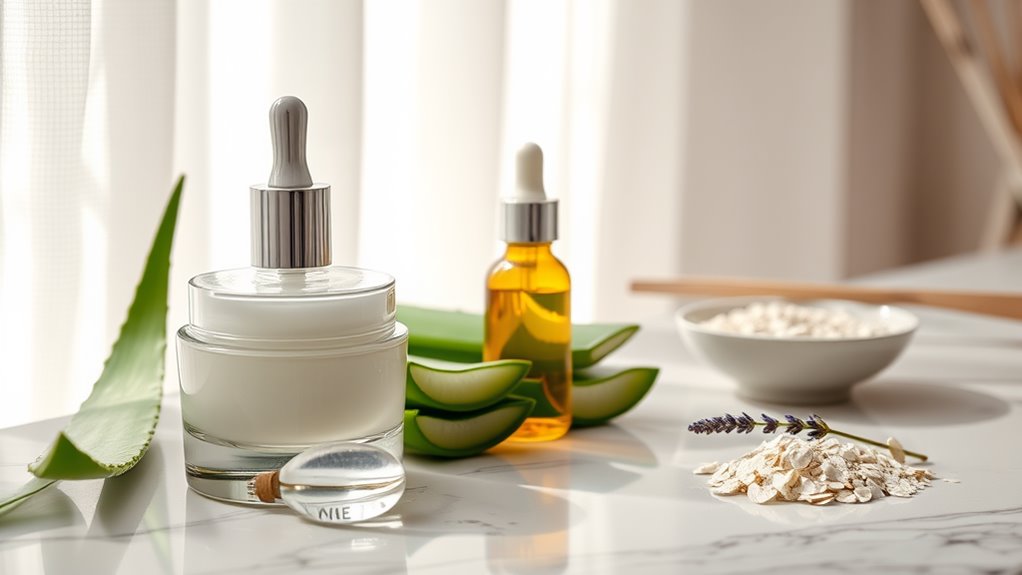The Best Way to Deal With Seasonal Skin Issues
To effectively deal with seasonal skin issues, adapt your skincare routine to match the changing environment. In spring and summer, use lightweight, non-comedogenic products, while during fall and winter, opt for richer, hydrating formulations. Stay hydrated by drinking enough water and using moisturizers with hyaluronic acid or glycerin. Always apply broad-spectrum sunscreen, regardless of the season, to protect against UV damage. Understanding your skin type will further enhance your routine; discover more tips on managing seasonal skin challenges.
Key Takeaways
- Adjust your skincare routine seasonally to address changes in humidity and temperature, using lightweight products in spring and richer formulations in winter.
- Identify your skin type to choose appropriate cleansers and moisturizers that cater to specific needs, such as oily, dry, or sensitive skin.
- Prioritize hydration by drinking water, using humidifiers, and selecting moisturizers with hydrating ingredients like hyaluronic acid or glycerin.
- Incorporate regular exfoliation into your routine to remove dead skin cells, promoting cell turnover without overdoing it to prevent irritation.
- Always apply broad-spectrum sunscreen with at least SPF 30 daily to protect your skin from UV damage, regardless of the season.
Understanding Seasonal Skin Changes
As the seasons shift, your skin undergoes various changes that can impact its health and appearance. Understanding these seasonal skin changes is crucial for optimizing your skincare routine.
In spring, for instance, increased humidity can lead to oiliness, necessitating lightweight, non-comedogenic products. Conversely, winter’s dry air often results in dehydration, requiring richer, hydrating formulations to restore moisture. A seasonal skincare guide helps you navigate these transitions effectively. Incorporating antioxidants in warmer months can protect against UV damage, while nourishing ingredients like hyaluronic acid are vital in colder months. Additionally, being aware of seasonal skin issues can further enhance your ability to adapt your routine to changing weather conditions.
Common Seasonal Skin Issues
As the seasons change, you may notice common skin issues such as dry skin, allergic reactions, and increased susceptibility to sun damage. Understanding these conditions can help you take proactive steps to protect your skin. Recognizing symptoms early allows for effective management and treatment. Additionally, incorporating winter skincare swaps into your routine can enhance hydration and protect your skin against the harsh cold.
Dry Skin Symptoms
Dry skin, often a common occurrence during seasonal transitions, manifests through several distinct symptoms.
You may notice a tight or itchy sensation, particularly after bathing or exposure to dry air. Skin may appear flaky or rough, with visible scaling on areas like elbows and knees. Cracks can develop, leading to discomfort or even bleeding in severe cases.
Additionally, your skin might exhibit a dull, ashy appearance, lacking the usual luster. Redness or inflammation may accompany these symptoms, indicating irritation.
Understanding these signs is crucial for effective management. By recognizing dry skin symptoms early, you can implement appropriate interventions to restore hydration and maintain skin integrity during seasonal changes.
Allergic Reactions Overview
Seasonal changes can trigger allergic reactions that affect the skin, presenting a range of symptoms that demand attention. Understanding these reactions is crucial for effective management. Common allergens include pollen, mold, and dust mites.
| Symptom | Description | Management |
|---|---|---|
| Rash | Red, itchy patches on the skin | Topical corticosteroids |
| Hives | Raised, swollen welts | Antihistamines |
| Eczema flare-up | Dry, inflamed skin | Moisturizers |
Identifying triggers can help you prevent future outbreaks. If you experience persistent symptoms, consult a dermatologist for tailored solutions. Mastering your skin’s responses ensures you can enjoy seasonal transitions without discomfort.
Sun Damage Prevention
Allergic reactions can heighten skin sensitivity, making it even more important to protect against sun damage during warmer months.
To effectively prevent sun damage, you should apply a broad-spectrum sunscreen with an SPF of 30 or higher, even on cloudy days. Reapply every two hours, or more frequently if swimming or sweating.
Wear protective clothing, such as long sleeves and wide-brimmed hats, to minimize direct sun exposure. Consider seeking shade, especially during peak sunlight hours, typically between 10 a.m. and 4 p.m.
Additionally, be mindful of reflective surfaces, like water and sand, which can intensify UV exposure.
Regularly inspect your skin for any changes, and consult a dermatologist for personalized recommendations tailored to your specific skin type and concerns.
Identifying Your Skin Type
Identifying your skin type is crucial for effective skincare, as it influences your choice of products and treatments.
You’ll typically find your skin categorized as oily, dry, or sensitive, each having distinct characteristics.
Understanding these traits helps you tailor your routine to maintain healthy, balanced skin throughout the seasons. Additionally, recognizing your skin type allows you to choose the right skincare that can effectively address seasonal changes and specific concerns.
Oily vs. Dry Skin
When the weather changes, understanding whether you have oily or dry skin can significantly impact your skincare routine.
Oily skin typically appears shiny, has enlarged pores, and may be prone to acne breakouts. You might notice excess oil production, especially in warmer months.
In contrast, dry skin often feels tight, rough, or flaky and can exhibit redness or irritation. It generally lacks moisture and may worsen in cold conditions.
To identify your skin type accurately, observe how your skin behaves after cleansing: if it feels tight, you likely have dry skin; if it becomes shiny within hours, you probably have oily skin.
Knowing your skin type allows you to tailor your products and techniques for optimal care.
Sensitive Skin Characteristics
Sensitive skin can often feel like a puzzle, making it crucial to recognize its unique characteristics. You might notice increased reactivity to products, such as burning or stinging sensations after application.
Redness and inflammation often accompany this sensitivity, signaling an impaired skin barrier. Furthermore, you may experience dryness or flakiness, exacerbated by environmental factors or harsh ingredients.
Pay attention to specific triggers, like temperature changes, fragrances, or certain fabrics, as they can provoke irritation. It’s essential to adopt a gentle skincare regimen, prioritizing soothing ingredients like aloe vera or chamomile.
Understanding these traits will empower you to manage your sensitive skin effectively, minimizing discomfort and maintaining overall health.
Importance of a Skincare Routine
A consistent skincare routine is essential for maintaining healthy skin, especially as seasonal changes can exacerbate various skin issues.
Establishing a regimen tailored to your skin type and concerns helps regulate oil production, minimize breakouts, and enhance overall skin texture. Incorporating specific products—cleansers, exfoliants, and treatments—ensures effective removal of impurities and dead skin cells while promoting cell turnover.
Moreover, consistency boosts your skin’s resilience against environmental stressors, such as UV rays and pollutants. By diligently applying serums and moisturizers, you enhance absorption of active ingredients, optimizing their benefits.
Additionally, understanding the principles of layering skincare products can further amplify the effectiveness of your routine.
Remember, the effectiveness of your routine depends on adherence; skipping steps can lead to imbalances.
Ultimately, mastering your skincare routine empowers you to achieve and maintain optimal skin health throughout the year.
Hydration: The Key to Healthy Skin
Maintaining moisture balance is essential for healthy skin, especially during seasonal changes. You can enhance your skin’s hydration through various techniques and tips tailored to your unique needs. Understanding these methods will empower you to effectively nourish and protect your skin throughout the year. Additionally, being aware of common moisturizer myths can help you choose the right products for optimal hydration.
Importance of Moisture Balance
While you may not realize it, the moisture balance of your skin plays a crucial role in its overall health and appearance. Proper hydration supports the skin’s barrier function, preventing transepidermal water loss and reducing the risk of irritation and inflammation.
When your skin is adequately moisturized, it maintains elasticity and suppleness, which helps combat dryness and flakiness. Conversely, an imbalance can lead to excessive oiliness or dryness, triggering conditions like acne or dermatitis.
Achieving optimal moisture balance involves understanding your skin type and environmental factors. By prioritizing hydration, you enhance your skin’s resilience, enabling it to better withstand seasonal changes and external stressors.
Ultimately, moisture balance is essential for achieving and maintaining healthy, vibrant skin.
Hydration Techniques and Tips
To achieve optimal skin hydration, it’s essential to implement effective techniques tailored to your individual needs.
Here are four key hydration techniques to master:
-
Drink Water Regularly: Aim for at least eight 8-ounce glasses daily to maintain internal moisture levels.
-
Use Humidifiers: Introduce humidity into your environment, especially in dry seasons, to prevent moisture loss.
-
Choose the Right Moisturizer: Select a product with hyaluronic acid or glycerin to attract and retain water in the skin.
-
Limit Hot Water Exposure: Reduce long, hot showers; use lukewarm water instead to avoid stripping natural oils.
Choosing the Right Cleanser
Selecting the right cleanser is crucial for addressing seasonal skin issues effectively.
Start by assessing your skin type—whether it’s oily, dry, combination, or sensitive. For oily skin, opt for a foaming or gel-based cleanser that removes excess oil without stripping moisture.
If your skin is dry, choose a creamy, hydrating cleanser with nourishing ingredients like glycerin or ceramides. For sensitive skin, look for fragrance-free, gentle formulas that minimize irritation.
Pay attention to seasonal changes; switch to a more hydrating cleanser in winter and a lighter one in summer.
Always conduct a patch test when trying a new product to avoid adverse reactions.
A well-chosen cleanser sets a solid foundation for your skincare routine and enhances overall skin health.
Exfoliation for Seasonal Skin Care
Exfoliation plays a vital role in seasonal skin care, as it helps remove dead skin cells and promotes cell turnover.
By incorporating exfoliation into your routine, you can achieve a smoother, more radiant complexion, especially as seasons change.
Here’s how to effectively exfoliate:
-
Choose the Right Exfoliant: Consider chemical exfoliants like AHAs or BHAs for deeper penetration or physical exfoliants for surface-level smoothing.
-
Frequency Matters: Exfoliate 1-3 times a week, depending on your skin type and sensitivity.
-
Don’t Overdo It: Over-exfoliating can lead to irritation, so listen to your skin’s needs.
-
Follow with Care: Always apply a suitable moisturizer post-exfoliation to maintain hydration and balance.
Mastering exfoliation will enhance your seasonal skin care routine.
Moisturizers for Different Seasons
As temperatures fluctuate throughout the year, adjusting your moisturizer becomes essential for maintaining optimal skin hydration and health.
In winter, opt for thicker creams containing occlusives like shea butter or petrolatum to combat dryness and prevent moisture loss.
During spring and fall, lighter lotions with humectants such as glycerin can effectively retain hydration without clogging pores.
In summer, gel-based moisturizers or oil-free formulas are ideal, as they provide hydration while keeping your skin feeling fresh and light.
Always choose products tailored to your skin type—whether oily, dry, or combination—to enhance efficacy.
Sun Protection Year-Round
Moisturizing is just one part of a comprehensive skincare routine; sun protection is equally important throughout the year.
UV rays can damage your skin even in cooler months, so adopting a year-round sun protection strategy is essential.
Here are four key steps to ensure effective sun protection:
-
Use Broad-Spectrum SPF****: Apply a broad-spectrum sunscreen with at least SPF 30 daily, regardless of the season.
-
Reapply Regularly: Reapply sunscreen every two hours, or more frequently if you’re sweating or swimming.
-
Wear Protective Clothing: Invest in UV-protective clothing, hats, and sunglasses to shield your skin.
-
Seek Shade: Limit direct sun exposure, especially during peak hours (10 a.m. to 4 p.m.).
Natural Remedies for Seasonal Skin Problems
Seasonal skin problems often arise due to changes in weather and environmental conditions, leading to dryness, irritation, or breakouts.
To combat these issues naturally, consider using aloe vera gel for its soothing and hydrating properties. Coconut oil serves as an effective moisturizer, penetrating deeply to alleviate dryness. Oatmeal baths can calm irritated skin and reduce inflammation.
For breakouts, tea tree oil offers antibacterial benefits; dilute it before application. Additionally, incorporating omega-3 fatty acids into your diet—found in fatty fish and flaxseed—can enhance skin barrier function.
Finally, staying hydrated by drinking ample water supports overall skin health. Implementing these natural remedies can significantly improve your skin’s resilience against seasonal changes.
When to Seek Professional Help
When should you consider consulting a dermatologist for seasonal skin issues?
It’s crucial to recognize when home remedies aren’t enough. Here are four key indicators that warrant professional attention:
-
Persistent Symptoms: If your skin issues last longer than two weeks without improvement, it’s time to seek help.
-
Severe Discomfort: Experiencing intense itching, burning, or pain signals a need for expert evaluation.
-
Worsening Condition: If your skin condition escalates or spreads, don’t hesitate to consult a dermatologist.
-
Uncertainty: If you’re unsure about the nature of your skin issue, a professional can provide clarity and appropriate treatment options.
Taking these signs seriously can lead to effective management and relief for your seasonal skin problems.
Tips for Maintaining Healthy Skin Year-Round
Maintaining healthy skin throughout the year requires a consistent approach to skincare, regardless of seasonal changes.
Begin with a tailored cleansing routine that suits your skin type, ensuring you remove impurities without stripping essential oils. Incorporate a daily moisturizer to maintain hydration, adjusting its thickness based on humidity levels.
Regular exfoliation, approximately twice a week, promotes cell turnover and prevents buildup. Protect your skin with broad-spectrum sunscreen daily, even in winter months, to shield against UV damage.
Stay hydrated by drinking adequate water and consume a balanced diet rich in antioxidants to support skin health from within.
Lastly, monitor your skin’s response to environmental factors and adjust your regimen accordingly to achieve optimal results year-round.




